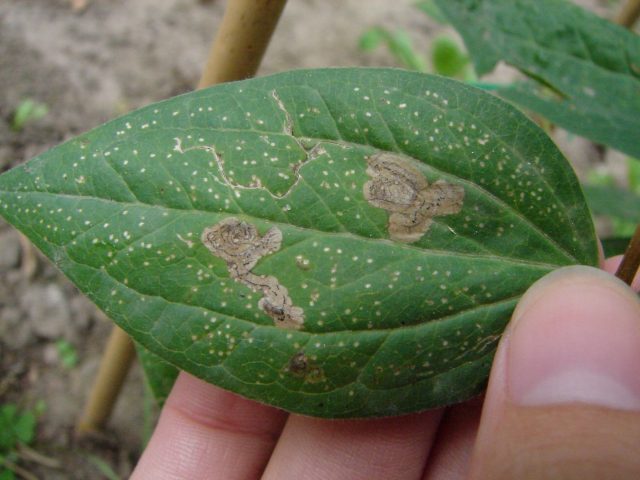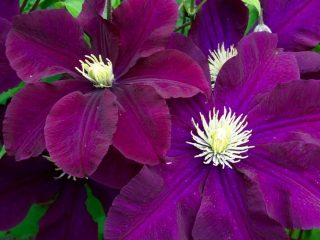Content
Clematis May Darling is an amazingly beautiful variety of clematis, bred in Poland. The plant will delight its owners with semi-double or double flowers, colored purple and red. Moreover, at the very end of summer, clematis, under favorable conditions, can bloom a second time.
Description of clematis May Darling
May Darling is distinguished by flowers with a diameter of 17 to 22 cm. Purple with red, they have pink stripes, as well as a white uneven color. The plant blooms for the first time in June and July, the buds during this period are clearly double. The second flowering occurs already in August, this time the flowers are smaller or simpler.
In the photo, clematis May Darling has dark green foliage. The plates are heart-shaped, trifoliate, pointed at the ends, and resemble an ellipse in shape.
Planting and caring for clematis May Darling
This variety of clematis can be grown in flower beds and is also suitable for container cultivation. For planting, you should choose a well-lit area, but so that there is no strong direct sun. The soil should be rich in nutrients. In terms of pH, neutral or slightly acidic soil is suitable.The plant requires moisture, but if water stagnates in the roots, it will hurt, so when planting it is necessary to prepare drainage for it.
May Darling is part of the group of frost-resistant clematis, favorable zones are from 4 to 9. Before transplanting into open ground, containers with purchased seedlings are kept in a room with a temperature of 0 to +2 ° C. Plant only when the possibility of frost has passed.
Stages of planting clematis:
- Immerse the container with the young plant in a container of water for 10-20 minutes so that the earthen lump is well wet.
- Prepare a hole with dimensions and a depth of 0.6 m. Pour crushed stone and stones for drainage at the bottom with a layer height of 10 cm.
- Be sure to add rotted manure or compost, about a bucket, sprinkle with soil on top.
- Bury the seedling a little more than it grew in the container (10 cm). The distance between neighboring plants or a wall is about 30-50 cm.
- Lightly shade the lower part of the stem and mulch the area around the bush with bark.
During the growing season, starting in spring, clematis is fertilized several times.
After the snow melts, add a solution prepared from 20 g of urea to a bucket of water. In the summer, they are fed with manure twice; in the fall, a complex of fertilizers made from phosphorus salts and potassium compounds is used for these purposes. In order for it to overwinter well, about 10-15 cm of its trunk is sprinkled with earth. All shoots are removed from the support, placed compactly on a bedding of foliage or spruce branches, and covered with the same plant materials. The thickness of the insulation is 25-30 cm.
At the very end of February or beginning of March, dead shoots are removed. The flower is pruned depending on its age: in the first year to a level of 30 cm above good buds, in the second year it is left at 70 cm, then it is kept no more than 1.5 m in height.
Reproduction
Clematis grandiflora May Darling can not be replanted for 10-12 years. The plant is propagated by seeds, division or layering, or cuttings. The vegetative method is preferable. If the bush is not very old (up to 5 years), you can simply divide it. In older specimens, it will be difficult to disassemble the rhizome into parts. Divide each dug clematis bush so that the divisions have buds on the root collar.
In the spring, shoots can be pinned. Last year's young branches at the site of the node should be pressed with a bracket into a pot with fairly loose soil, to which peat has been added. As the shoot grows, add soil to the pot. In the fall, in this way, new seedlings will be ready for replanting.
To grow clematis from seeds, you need:
- At the end of winter, soak the grains in water for 7-10 days, making sure to change the liquid several times a day.
- Mix sand, peat and soil in equal volumes. Place the seeds in prepared containers with such a substrate, cover them with 2 cm of sand on top. Make a greenhouse - cover with glass and film.
- The seeds are kept in warm conditions and watered in a tray.
- When shoots appear above the sand, the greenhouse is removed.
- When real leaves appear, clematis seedlings are planted in separate pots.
- After the frosts have subsided, you can plant them in open ground. Plants are pinched so that they grow rhizomes. They must be covered for the winter.
Diseases and pests
Many gardeners post on the Internet photos and descriptions of the May Darling clematis that they grow in their garden.The plant is beautiful, but, according to reviews, it can be susceptible to various diseases.
Most often, clematis variety May Darling suffers from problems such as:
- rot;
- verticellosis;
- rust;
- viral yellow mosaic;
- powdery mildew;
- ascochyta blight
Of the pests, it is attacked by nematodes. They settle on the roots. Therefore, when transplanting, the rhizome must be carefully examined. If their galls are discovered, then new clematis cannot be planted in this place for several years.
The most common problem with Mai Darling is wilting. At the same time, the foliage and shoots lose their elasticity and begin to dry out. The roots are the first to be affected. To save the flower, it is watered with a 2% solution of Fundazol. If the bush is severely affected, you will have to destroy the entire plant and treat the area with Azocene or Fundazol.
The fungus attacks clematis in the form of rust, which appears as orange tubercles on the foliage and branches. For treatment and prevention, it is necessary to practice spraying the bushes with a solution of Bordeaux mixture or other copper preparations. The concentration of the solution is within 1-2%.
Copper sulfate will help if the flower is sick with ascochyta blight. With this problem, bright yellow spots appear on the plant, usually this occurs in mid-summer. If May Darling is infected with the yellow mosaic virus, then there will be no salvation - the bushes will have to be destroyed. To prevent this from happening, it is better to plant clematis away from plants prone to this disease (hostas, peonies, phlox, delphiniums).
Conclusion
Clematis May Darling is not a very capricious plant. Liana May Darling with purple flowers will become a real decoration of a suburban area, especially since the plant blooms twice during the summer.












